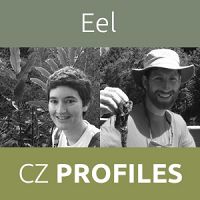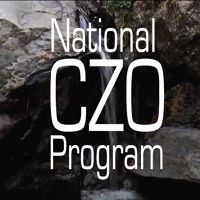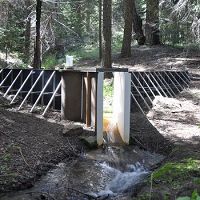RESEARCH



Do not fill out this information.
On this particular page, the Initial Text and Image fields for this template are not used (inactive). A Carousel Slideshow is displayed instead.
To edit the Carousel Slideshow, Choose Edit Existing > Carousel Slides. Then navigate to your CZO's entry entitled "Research"
Our focus is on watershed currencies that are mediated by the critical zone and that link atmosphere, the critical zone, rivers, watersheds, ocean, and terrestrial and aquatic ecosystems.
Fig 1. The critical zone of vegetation (green), soil and weathered bedrock with perched water table (red to blue), overlying fresh bedrock (grey) that exchanges currencies (arrows) with atmosphere (cloud) and mediates effluents (curved arrow) to a channel network (lines) which drain to ocean (blue triangle).
California's Eel River Critical Zone Observatory is rooted in intensive field monitoring in the critical zone, which follows watershed currencies (water, solutes, gasses, biota, sediment, energy, and momentum) through a subsurface physical environment and microbial ecosystem of the critical zone into the terrestrial ecosystem, up into the atmosphere, and out through drainage networks to the coastal ocean (Figure 1).
Soil, forest, and riverine ecosystems interact with these currencies, mediating the delivery of nutrients to the sea. CZO investigations will co-evolve with a synthesis model that mechanistically links the critical zone to atmospheric processes, watershed routing, ecosystems dynamics, stream flow, and coastal processes in order to investigate fundamental questions and to provide a modeling tool for management issues.
The Eel River CZO is examining:
-
Does lithology control rock moisture availability to plants and therefore overall resilience of vegetation to climate change in seasonally dry environments?
-
How are solute and gas effluents from hillslopes influenced by biota in changing moisture regimes?
-
What controls the spatial extent of wetted channels in the channel networks of seasonally dry environments?
-
Will changes in critical zone currencies induced by climate or land use change lead to threshold-type switches in river and coastal ecosystems?
Our observatory operates at four distinct scales: 1) the hillslope (our critical zone workshop), 2) the stream reach (where critical zone currencies dictate water supply, extent of wetted channel, and the emergent aquatic ecosystem), 3) the whole watershed scale (nearly 10,000 km2), and 4) the regional scale (>13,000 km2). Read more about our field areas.
Motivated by anticipated increase in climate extremes (especially extended drought) and accelerating societal demand for water, we focus on filling knowledge gaps that not only inhibit our ability to forecast the magnitude of future change of systems, but even the sign of that change. We are also developing a modular coupled model (AWESOM) which will provide local predictions over a regional scale and that can be used to ask “what if” questions about possible future climate and landuse scenarios and the consequences on runoff and ecosystem states.
Fig 1. The critical zone of vegetation (green), soil and weathered bedrock with perched water table (red to blue), overlying fresh bedrock (grey) that exchanges currencies (arrows) with atmosphere (cloud) and mediates effluents (curved arrow) to a channel network (lines) which drain to ocean (blue triangle).
Angelo Reserve
Research News

FEATURED NATIONALLY
NSF Blog: No soils, no life
27 Oct 2020 - They’re beneath our feet, but we seldom hear important signals in the soils

FEATURED NATIONALLY
2020 CZO Webinar Series on Sustainability
17 Jun 2020 - For an updated listing of these talks, including abstracts, see /national/education-outreach/sustainability-2020/ The U.S....

FEATURED
CZOs at AGU 2019
19 Nov 2019 - A list of CZ-related sessions, abstracts and events at the 2019 AGU Fall Meeting.

FEATURED
CZ colleagues: Please contact us about proposals for NSF’s CZ Collaborative Network, due 02 Dec 2019
08 Jul 2019 - CZO will end Nov 2020, succeeded by the “CZ Collaborative Network”. Let’s explore how the CZ community can build upon the CZOs via new NSF proposals.

FEATURED
EOS: Answer to California Landscape Riddle Lies Underground
31 May 2019 - Scientists link vegetation mosaics in California to patterns of weathered bedrock.

FEATURED
CZOs at AGU 2018
19 Nov 2018 - The 2018 AGU Fall Meeting will be held December 10-14 in Washington, D.C.

FEATURED
NSF Discovery articles focus on the CZOs.
10 May 2018 - The Discoveries section of the National Science Foundation's website on Critical Zone Observatories (CZOs).

FEATURED
Recent paper by Rempe and Dietrich on rock moisture featured by NSF and others
02 Mar 2018 - A recent paper on rock moisture by Danielle Rempe and Bill Dietrich of the Eel River CZO is been featured on NSF News site, SF Chronicle, others

FEATURED
On World Water Day, scientists peer into rivers to answer water availability questions
21 Mar 2016 - The following is part nine in a series on the National Science Foundation's Critical Zone Observatories (CZO) Network.

FEATURED
The critical zone: Studying where all of life happens
18 Feb 2016 - Science isn’t generally considered an extreme sport, but you wouldn’t know that by watching researchers in the Eel River Critical Zone Observatory.

FEATURED
Recent study underscores the environmental cost of illegal marijuana cultivation
29 Jul 2015 - Eel River CZO ecohydrologist Sally Thompson and ecologists Stephanie Carlson and Mary Power worked with The Nature Conservancy to explore the...

FEATURED
Ecology From Treetop To Bedrock: Human Influence In Earth’s Critical Zone
17 Jul 2015 - An Organized Session On Critical Zone Ecology At The 100th Annual Meeting Of The Ecological Society Of America August 9-14, 2015 In Baltimore, Md.

FEATURED
Critical Zone Profiles - Meet the people doing CZO science (Eel River CZO)
19 Mar 2015 - Get a sense of the people and the work. Several members of the Eel River CZO are profiled here, including students and professors.

Congratulations Jill Marshall on receiving the 2018 Luna B. Leopold Young Scientist Award
06 Nov 2018 - Marshall Receives 2018 Luna B. Leopold Young Scientist Award

White paper of 2017 CZ Science Meeting in Arlington, VA
01 Jan 2018 - New Opportunities for Critical Zone Science Following the June 2017 Arlington Meeting for Critical Zone Science (hosted by CZO), a white booklet...

CZOs at AGU 2017
05 Dec 2017 - Information on CZO award recipients, events, presentations, etc. at the 2017 AGU Fall Meeting.

Water Resources Research Special Collection: Concentration-discharge relations in the critical zone
30 Oct 2017 - Water Resources Research published a new special collection in September 2017 featuring concentration-discharge research from multiple CZOs.

ERCZO research featured in Lawrence Hall of Science video: Studying the Eel River Watershed
25 Jun 2017 - Eel River CZO researchers are featured in a new video at the Lawrence Hall of Science.
Example Publications
FEATURED
Effect of source habitat spatial heterogeneity and species diversity on the temporal stability of aquatic‐to‐terrestrial subsidy by emerging aquatic insects. Uno, H., and Pneh, S. (2020): Ecological Research 35 (3): 474–481
FEATURED NATIONALLY
Digging deeper: what the critical zone perspective adds to the study of plant ecophysiology. Dawson, T.E., Hahm, W.J., & Crutchfield-Peters, K. (2020): New Phytologist 226 (3): 666-671
FEATURED NATIONALLY
Temporal dynamics of migration‐linked genetic variation are driven by streamflows and riverscape permeability. Kelson, S.J., Miller, M.R., Thompson, T.Q., O'Rourke, S.M. & Carlson, S.M. (2020): Molecular Ecology 29 (5): 870-885
FEATURED NATIONALLY
Resolving Deep Critical Zone Architecture in Complex Volcanic Terrain. Moravec B.G., White A.M., Root R.A, Sanchez A., Olshansky Y., Paras B.K., Carr B., McIntosh J., Pelletier J.D., Rasmussen C., Holbrook W.S., Chorover J. (2020): Journal of Geophysical Research: Earth Surface 125(1): e2019JF005189 Cross-CZO
FEATURED
Ecological and genomic attributes of novel bacterial taxa that thrive in subsurface soil horizons. Brewer, Tess E., Emma L. Aronson, Keshav Arogyaswamy, Sharon A. Billings, Jon K. Botthoff, Ashley N. Campbell, Nicholas C. Dove, Dawson Fairbanks, Rachel E. Gallery, Stephen C. Hart, Jason Kaye, Gary King, Geoffrey Logan, Kathleen A. Lohse, Mia R. Maltz, Emilio Mayorga, Caitlin O’Neill, Sarah M. Owens, Aaron Packman, Jennifer Pett-Ridge, Alain F. Plante, Daniel D. Richter, Whendee L. Silver, Wendy H. Yang, Noah Fierer (2019): mBio Oct 2019, 10 (5) e01318-19 Cross-CZO National
FEATURED
Mercury sourcing and sequestration in weathering profiles at six Critical Zone Observatories. Richardson, Justin B., Arnulfo A. Aguirre, Heather L. Buss, A. Toby O'Geen, Xin Gu, Daniella M. Rempe, and Daniel deB. Richter (2018): Global Biogeochemical Cycles, 32(10):1542-1555 Cross-CZO National
FEATURED
High Time for Conservation: Adding the Environment to the Debate on Marijuana Liberalization. Carah, J., Howard, J., Thompson, S.E., Short Gianotti, A.G., Bauer, S., Carlson, S.M., Dralle, D.N., Gabriel, M.W., Hulette, L., Johnson, B., Knight, C., Kupferberg, S., Martin, S., Naylor, R., Power, M.E. (2015): BioScience (Advance Access)
Clades of huge phages from across Earth’s ecosystems. Al-Shayeb, B., R. Sachdeva, L.-X. Chen, F. Ward, P. Munk, A. Devoto, C. J. Castelle, M. R. Olm, K. Bouma-Gregson, Y. Amano, C. He, R. Meheust, B. Brooks, A. Thomas, A. Lavy, P. Matheus-Carnevali, C. Sun, D. S. A. Goltsman, M. A. Borton, A. Sharrar, A. L. Jaffe, T. C. Nelson, R. Kantor, R. Keren, K. R. Lane, I. F. Farag, S. Lei, K. Finstad, R. Amundson, K. Anantharaman, J. Zhou, A. J. Probst, M. E. Power, S. G. Tringe, W.-J. Li, K. Wrighton, S. Harrison, M. Morowitz, D. A. Relman, J. A. Doudna, A.-C. Lehours, L. Warren, J. H. D. Cate, J. M. Santini, and J. F. Banfield. (2020): Nature 578, 425–431
Combined use of radiocarbon and stable carbon isotopes for the source mixing model in a stream food web. Ishikawa, N.F., Finlay, J.C., Uno, H., Ogawa, N.O., Ohkouchi, N., Tayasu, T., Power, and Power, M.E. (2020): Limnology and Oceanography 1-14
Lifetime eurythermy by seasonally matched thermal performance of developmental stages in an annual aquatic insect. Uno, H. and Stillman, J.H. (2020): Oecologia 192: 647–656
Tributary confluences are dynamic thermal refuges for a juvenile salmonid in a warming river network. Wang, T., Kelson, S.J., Greer, G., Thompson, S.E., and S.M. Carlson (2020): River Research and Applications
Partial migration alters population ecology and food chain length: evidence from a salmonid fish. Kelson, S. J., Power, M.E., Finlay, J.C., and S. M. Carlson (2020): Ecosphere 11 (2): e03044
Bacterial Secondary Metabolite Biosynthetic Potential in Soil Varies with Phylum, Depth, and Vegetation Type. Sharrar, A.M., Crits-Christoph, A., Méheust, R., Diamond, S., Starr, E.P., and Banfield, J.F. (2020): mBio 11 (3): e00416-20
Mediterranean grassland soil C–N compound turnover is dependent on rainfall and depth, and is mediated by genomically divergent microorganisms. Diamond, S., Andeer, P.F., Li, Z., Crits-Christoph, A., Burstein, D., Anantharaman, A., Lane, K.R., Thomas, B.C., Pan, C., Northen, T.R., and Banfield, J.F. (2019): Nature Microbiology 4: 1356–1367
Explore Further

